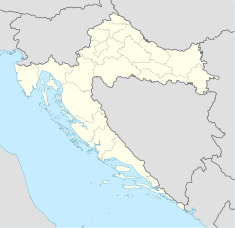Cathedral of St. Lawrence, Trogir
| Cathedral of St. Lawrence | |
|---|---|
|
Native name Croatian: Katedrala Sv. Lovre |
|

Bell Tower of St. Lawrence
|
|
| Location |
|
| Coordinates | 43°31′1.5″N 16°15′05″E / 43.517083°N 16.25139°ECoordinates: 43°31′1.5″N 16°15′05″E / 43.517083°N 16.25139°E |
| Area | 6.40 ha (15.8 acres) |
| Built | 13th century |
| Architectural style(s) | Romanesque, Gothic |
| Type | Cultural |
| Criteria | ii, iv |
| Designated | 1997 (21st Session) |
| Reference no. | 810 |
| Official name: Katedrala Sv. Lovre | |
The Cathedral of St. Lawrence (Croatian: Katedrala Sv. Lovre) is a Roman Catholic triple-naved basilica constructed in Romanesque-Gothic in Trogir, Croatia. Since its construction lasted several centuries, it illustrates all the styles that succeeded one another in Dalmatia. It serves now as the most imposing monument in the city of Trogir.
It was built on the foundations of an Early Christian cathedral destroyed in the 12th century during the sack of the town by the Saracens in 1123. The building of the cathedral began in 1213 and finished during the 17th century. Like the older one, it is also dedicated to St. Lawrence (Sveti Lovro) but it is better known as St. John's Cathedral (Sveti Ivan) after bishop John, who died in 1111 and stood out for his saintly lifestyle at a time when the Hungarian King Koloman had taken over Dalmatia and Croatia. Most of the work in the construction of the cathedral took place in the 13th century, being mostly completed in 1251. That means the building is mainly in Romanesque style, whilst the vault inside is gothic as it was built during the 15th century, in Mannerist style.
Work on the bell tower began at the end of the 14th century, but it was not completed until the end of the 16th century. The first floor is in Gothic style and it was built by Masters Stejpan and Matej. After it had been demolished by the Venetians in 1420, it was restored by Matija Gojković. The second floor is in low Gothic style and was probably the work of Venetian masters, as it is reminiscent of the windows of the famous Venetian Palazzo Ca d'Oro. The final floor was built by Trifun Bokanić (1575–1609). On top of the bell tower there are four statues, the work of Venetian sculptor Alessandro Vittoria (1525–1608). In the centre of the facade, within a small round opening, there is the carved coat of arms of the most powerful King, Ludvic of Angevin dynasty.
Trogir cathedral is the most archaic example in the construction of interior arcades in Dalmatia with heavy elongated piers separating the two Gothic-ribbed aisles from the nave, vaulted later also in Gothic style in the 15th century, three semi-circular apses and a vaulted interior above which rises the Campanile. Unfortunately, only one of the two planned towers (the southern), was raised. The cross vaults and the earlier terraces above the aisles are of Apulian influence.
...
Wikipedia

